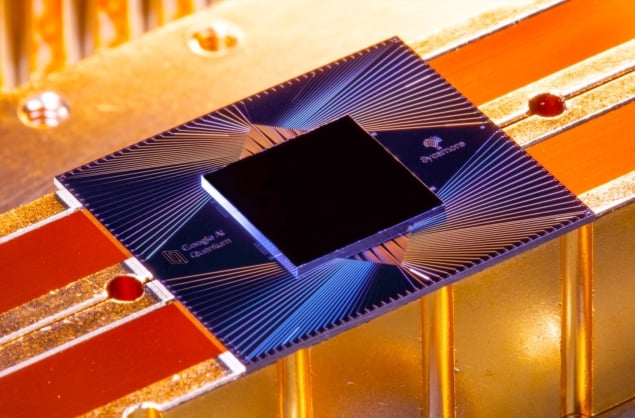
Simulating chemical processes is one of the most promising applications of quantum computers, but problems with noise have prevented nascent quantum systems from outperforming conventional computers on such tasks. Now, researchers at Google have taken a major step towards this goal by using the most powerful quantum computer yet built to successfully implement a protocol for calculating the electronic structure of a molecule. The results may form a blueprint for complex, useful calculations on quantum computers affected by noise.
In October 2019, Google announced to great fanfare that its 53-qubit Sycamore computer had achieved quantum advantage. This means that a quantum computer can solve at least one problem much faster than any conventional supercomputer. However, Google researchers openly acknowledged that the problem Sycamore solved (sampling the outcome of a random quantum circuit) is easy for a quantum computer but difficult for a conventional supercomputer — and had little practical use.
What researchers would really like to do is use quantum computers to solve useful problems more effectively than possible with conventional computers: “Sycamore is extremely programmable and, in principle, you really can run any algorithm on it…In this sense, it’s a universal quantum computer,” explains team member Ryan Babbush of Google Research, “However, there’s a heavy caveat: there’s still noise affecting the device and as a result we’re still limited in the size of circuit we can implement.” Such noise, which results from classical sources such as thermal interference, can destroy the fragile superpositions crucial to quantum computation: “We can implement a completely universal circuit before the noise catches up and eventually destroys the computation,” says Babbush.
Hartree-Fock procedure
In the new research, the team used Sycamore to implement the Hartree-Fock procedure – a well-established method for calculating the electronic structure of molecular systems – and applied it to the isomerization of diazene. This is significantly more complex than previous simulations on quantum computers, increasing the maximum number of qubits used from six to 12.
Each successive qubit brings additional potential for noise: “You need to perform some type of error mitigation,” says Google Research’s Nick Rubin: “The extreme way – and this is something that the Google team is building towards – is to build an error corrected quantum computer, which involves turning a quantum computation into a digital quantum computation and correcting any errors that occur along the way”.
In the absence of this, however, Rubin developed a mathematical error mitigation technique that allowed noise to be identified and discarded. Using this technique and others, Rubin explains, the researchers could “lower the error rates of Sycamore through calibration and then apply algorithmic error mitigation to see the – in this case – chemistry at high fidelity.” Their results matched those from a conventional computer.
More complex simulations
Ironically, the structures predicted by the simple Hartree-Fock procedure for this molecule do not agree with measurements in the lab, but Babbush explains that the “notable deficiencies” of the Hartree-Fock procedure for structure prediction are irrelevant. “We certainly do want to build more complex simulations on top of it,” he says, “but even those will use the sub-routines we’ve developed here as a stepping stone.” Whether or not, with further improvements, it will prove possible to solve classically intractable problems in quantum chemistry on a so-called “noisy intermediate-scale quantum computer” (NISQ) using quantum error mitigation remains unknown: “Error mitigation will only take you so far,” says Babbush. “At some point all you’re going to be getting is noise, so it doesn’t matter whether you can tell whether it’s noise or not. To get past that point, you really need error correction.”

Google reports quantum supremacy in draft paper
“This work pushes the needle in quantum computing for chemistry,” says quantum chemist and computer scientist Alán Aspuru-Guzik of the University of Toronto in Canada. “It shows in an honest way what quantum computers can do today in a device. Compare this to what they could do a couple of years ago, and the progress is extraordinary. It is also worth saying that there is still a large open space for hardware improvements and clever algorithmic tricks.”
“We’re in this era of NISQ,” says quantum information scientist Barry Sanders at Canada’s University of Calgary. “I appreciate what they’re doing now, which is to say ‘let’s forget about universal quantum computing and let’s just push our technology to answer relevant problems.”
The research is described in Science.





